eISSN: 2093-8462 http://jesk.or.kr
Open Access, Peer-reviewed

eISSN: 2093-8462 http://jesk.or.kr
Open Access, Peer-reviewed
Shou Yi Yu
, Jun Ping Xu
, Su Min Jang
, Young Hwan Pan
10.5143/JESK.2024.43.1.95 Epub 2024 March 05
Abstract
Objective: The aim of this study is to improve the performance of AI artists from a technical perspective by using AI platforms and training methods that encompass aspects such as image quality, text alignment, text generation, inference time, and training efficiency.
Background: With the rise and rapid development of Artificial Intelligence (AI), the art market has embraced its use. The rise of AI in the art market has simultaneously increased the productivity of designer characterization. AI painting is developing rapidly, It would also be interesting to study attribution in this area.
Method: By analyzing traditional and AI-based character creation methods using questionnaires and conducting in-depth interviews with 14 participants.
Results: Anthropometry was the most dominant area all the time. Health and safety area has been steadily increasing in publication amount.
Conclusion: The research aims to improve the performance of AI artists in terms of image quality, text alignment, text generation, inference time and training efficiency through AI platforms and training methods. Users tend to use AI to improve artist efficiency and believe that images generated through AI have commercial uses. However, AI cannot replace the joy and exploration of artists in creation, but serves as a valuable tool to improve creativity and painting efficiency. AI tools will completely change our work and lives when the technology matures.
Application: Research contributes to the application of AI in character creation and promotes sustainable development in the art field. This study contributes to the process of AI in character creation, which can help to promote the sustainable development of AI in the field of art, and provides further expansion of the IP of painted characters in the possible space.
Keywords
Artificial Intelligence (AI) AI art User experience Character production Visual arts
With the development of AI, an art market using AI has emerged. In recent years, the market has undergone extensive digitization, which has led to the increasing availability of large digital art collections. This availability, combined with recent advances in pattern recognition and computer vision, has opened up new opportunities for researchers in the field of AI to assist domain experts, especially art historians, in studying and analyzing the visual arts. Some scholars discusses the application of AI in art design, with a forward-looking discussion of the prospects for AI applications in the art field (Deng, 2021).
Alice Barale discussed the impact of AI on art from the aspect of aesthetics (Alice, 2021); AI painting, as a product of AI and art, as the name suggests, is painting using AI tools or systems, which is one of the typical application scenarios of AI Generated Content (AIGC). Its main principle is to collect a large number of existing paintings, analyze and combine their content and style characteristics through algorithms, and finally generate new works, so algorithms are the core of AI painting. Since AI is constantly breaking through in the field of painting technology, in a sense, it is creating new content, which can also be understood as the mover of new paintings. In this way, not only artists and designers, but also anyone can use these creative AI tools to create works of art and apply them to actual creations.
Some scholars are asking interesting questions in the world in response to the works of AI and human artists in the world. This is a new era of art, will AI replace human artists? Is Everyone an Artist (Xu et al., 2023) Whether AI becomes a work of art is controversial (Liu, 2023), most people believe that AI painting is not a work of art, the main reason is that AI painting relies on a large number of access to images on the Internet for machine learning, but these images are often not only limited to publicly copyrighted images, but also contain a large number of CG artists' works.AI can emulate and quickly accomplish the experience that artists have accumulated over time to generate images This is contrary to the willingness of artists to post their work on social media platforms to reflect their self-worth (Roosa et al., 2022). There is also a differentiation between human cognitive artwork and human intelligent artwork. Researchers can focus on improving the AI algorithms to produce more realistic artworks because the acceptance and judgment of an artificial intelligent artwork is not based on a person's knowledge of or exposure to AI, but because art is a sensory field that depends on different people's experiences and personal preferences. Hong argues that based on the different aesthetic ratings of artworks, there may still be differences between artworks created by AI and those created by humans (Hong, 2018) and that having the stereotype that "AI cannot create art" This affects the evaluation of the value of art, assuming that aesthetic value is assessed independently of the biases associated with the artwork and its artist. A discussion of the relationship between these three components in the context of AI-produced artwork, he argues that art has a broader context than the artwork itself (Eugene, 2019). Including the artist and the art world in which both are located, and that aesthetic value is a necessary component of the argument , if the AI-generated image is to be a work of art it needs to satisfy first and foremost the artist, conditions and contexts of the artwork and the art world.
One part of the argument is that AI can be seen as creative, then it is creative (Roosa et al., 2022), based on the idea that the world is the world as we see it. Artwork is a medium with a message, so schema theory is applicable to research focused on artwork. The oil painting "Space Opera House", which won the first prize at an art fair organized by the State of Colorado in the United States, was, according to the interview, a work that he obtained only after repeated tests through the AI system and modifications and adjustments using other drawing tools (Zhang, 2023). The fact that this work was not entirely created by the AI, nor was it done independently by the author, suggests that it is a work of art created based on repeated training with an AI creation tool manipulated by a human.
In order to better understand the nature of machine learning, propagation and image datasets, and for relevant art or information professionals to better navigate this emerging technology. AI is widely used in art creation, design, and other fields, and user acceptance and behavioral intentions need to be studied and optimized to increase its effectiveness. The research objectives of this paper are users' perceptions of how AI can be used to generate images from text to generate images and images to generate images, as well as artists' evaluations of the process of using AI? In order to achieve the research objectives of this paper, a qualitative research methodology (in-depth interviews) approach was used to interview 14 respondents including artist producers, designers, and laypersons, with a particular focus on the user experience of the AI artwork production process.
AI and Machine Learning are developed based on the concept of repetition and learning (Sumit et al., 2015). At this stage, several companies have used AI to replace or support humans in tasks that run according to models. Arvind Krishna, Chief Executive Officer of technology giant IBM stated that AI can replace some of the human staff jobs in the coming years (Reimann, 2023). Therefore it is important to take the first step to understand how to operate and use AI.
Recent developments have shown that machine learning has made impressive advances, with its capabilities extending to generating images from text and even extending to transforming sound into images (Jeon, 2021). Runway is a good example of how AI can make artwork creation easier, it is a tool to help collaborate with AI in the creation of images and videos (Aela, 2023). The aim of this paper is to explore the differences between AI art and artworks created by human artists from the perspective of character creation through an in-depth analysis of the principles of AI (AI) and the practical use of manipulation. Through this research, we aim to explore the unique characteristics and artistry of AI art creation and gain insight into its interrelationship with traditional art creation.
2.1 AI artwork
The term Artificial Intelligence (AI) originated in the 1950s in the context of human cognitive modeling (Turing, 1950). Today, the term has evolved to refer to applications that rely on deep neural networks. Art with AI refers to artworks created by AI algorithms in collaboration with human artists (Ting et al., 2022). The main part of AI-generated art and its technology is artificial neural networks (ANNs), which have been developed since the mid-1900s. With the development of neural grids and deep learning techniques in the early 21st century, art with AI has been able to mimic the power and imagination of human creativity and imagination. In 2016, Google Deep Dream (GDD) used neural grid technology to train machine learning to recognize images and further create artistic images (Feng et al., 2018). In 2017, scientists further created CAN (Creative Adversarial Networks) program, which is a program for creating artificial neural networks (ANNs). Networks) program, a computer program that builds on the original GAN (Generative Adversarial Networks) by modifying the goal of the grid to deviate as much as possible from the established grid (Ahmed et al., 2017). This procedure allows the computer to stop simply copying the model and by mimicking human creative activity, it can create an independent artistic style.
The previous authors (Chamberlain et al., 2018) defined AI artwork as artwork created or generated with the help of AI (AI) technology. It involves the use of algorithms and machine learning techniques to produce visual or audiovisual content. AI can be used to create art in a variety of ways, from assisting human artists in the creative process to fully autonomous AI systems that generate original works of art. Lev Manovich is a leading cultural theorist and professor who explores the intersection of AI and art, discussing topics such as algorithmic aesthetics and the role of AI in the creative process (Marian and Ahmed, 2019). A computer scientist and artist who has extensively researched and written about the use of AI in art, including the use of Generative Adversarial Networks (GANs) and deep learning techniques. Kate Crawford As a researcher and scholar, Crawford studies the social and ethical implications of AI in a variety of fields, including the arts (Luke and Kate, 2019), delves into the broader implications of AI-generated art and its impact on the art world.
There are different approaches to AI art creation that can help generate complex patterns, textures, or color palettes based on an artist's inputs; AI models can be trained to learn the features and characteristics of various art styles, keywording them, and then applying those styles to other images or generating new works of art; and there is also generative art, which are systems that use techniques such as Generative Adversarial Networks (GANs) or Recurrent Neural Networks (RNN) and other techniques to create original visuals, music or other forms of artistic expression (Table 1).
|
Support and enhancement |
Assist the artist by providing suggestions, enhancing the creative
process, or generating specific elements of the artwork. |
|
Transition of styles |
AI algorithms make it possible to analyze
existing artwork and apply its style to new images. |
|
Generative art |
AI systems are trained to generate
entirely new work without explicit human guidance. |
In recent years, AI artwork has gained attention and popularity for its unique and often compelling output. It offers new possibilities for artistic exploration, blurring the line between human creativity and machine-generated content. AI art can evoke new emotions, challenge traditional artistic norms, and spark conversations about the nature of art and the role of technology in the creative process. Xu et al. combined the Technology Acceptance Model (TAM) with an AI-based painting system to explore the factors that influence user acceptance of AIBPS, thus facilitating developers to develop new features that improve the user's experience of using AI paintings (Xu et al., 2023). Therefore, this paper would like to do relevant research and discussion for users on character creation, and make theoretical support for the future development of the industry.
2.2 Principles of AI artwork production
First, the underlying technology framework can be broadly divided into several important phases (Table 2): GAN-The GAN (Generative Adversarial Network) is a deep learning model that generates and aligns images using a confrontational network in the image feature domain (Lan et al., 2014). It consists of two main modules: the G model (generation model) and the D model (discriminant model). Through mutual game learning, algorithm produces high-quality output results. It has broad applications and scalability, including image generation, data augmentation, and image processing.
Transform refers to the AI-NLP network is a robust framework for text and image encoding, combining self-attention and Feed Forward Neural Network (FFNN). It is a Seq2seq model without an RNN structure, making it suitable for tasks like machine translation, speech recognition, and speech synthesis.
CLIP means the alignment of image and text domain features is achieved using a unified framework of text and visual transformer encoding (Aditya, 2022).
Diffusion denotes raw image feature domain alignment is transformed into image noise domain alignment. Implemented based on a parameterized Markov chain framework.
|
Principle of AI
intelligent paintin STAGE |
|
|
GAN |
Deep Learning Model |
|
Transform |
Self-Atenion+Feed Forward
Neural Network |
|
CLIP |
Image Text Field Feature
Alignment |
|
Diffusion |
Based on a parameterized
Markov chain framework |
In the second evolutionary technology section, with the help of AI and machine learning techniques, Google is actively improving its search engine to provide more visually based search results and visual information retrieval methods. Currently, there are two main ways to use this: one is text-to-image, where the user enters a textual descriptor (prompt) to have the AI generate a corresponding image. Anyone can write a text describing the image they want the computer to generate for them. Another approach is image-to-image, where the AI understands and analyzes the image provided by the user and then regenerates a new image. Tools such as Midjourney, DALL-E 2, Stable Diffusion (Stable Diffusion Online), AIGREEM (AIGREEM Online), etc. are typical AI image generation tools. For example, the famous AI team OpenAI has released a model called DALL-E 2 (DALL-E API Now Available in Public Beta), named after the famous painter Dalí (Salvador Dalí) and the Robot Mastermind (Wall-E). The model is also capable of generating excellent quality images based on textual descriptions.
2.3 AI Artwork production program
Text-to-image are AI based techniques where AI uses Generative Adversarial Networks (GANs) or other deep learning models to generate corresponding images (Figure 1). Steps to a Text-to-image As an example, Midjourney, AI's hottest tool for creating images in recent times, is based on the creation method of Text-to-image (Word2Vec), which generates short, coherent texts by linking different words together.

Image-to-Image is the process of generating beautiful, creative images in Midjourney based on the descriptors in Discord. To use it, you need to set up a server using Discord and upload the image you want to convert or two images you want to merge according to your needs. It can also be used with keywords sent to the server to generate images (Figure 2).

Text-and-Image generation refers to the structural differences between different AI image generator technologies. The core technical capability of such AI generative models lies in the use of high-dimensional mathematical vectors to represent human-created content. If this content-to-vector conversion makes sense and captures the characteristics of the content, then all human-created content can be transformed into vectors in this vector space. When we convert all the content in the world into vectors, those vectors that cannot be represented in that space represent content that has not yet been created.
However, we already have vector representations of this known content, so we can reverse the transformation and use AI to "create" content that has not yet been created. First and foremost, being able to express images in text is the first step in creating artistic images. DALL-E 2, Imagen, and Midjourney are becoming increasingly popular as art creators that produce images when files are imported. In order to gain an understanding of these images, some examples are provided. When Midjourney is used to input a Maltese dog on a swim ring, but with no background description, the resulting image (Figure 3) is shown below. As follows, the screen produces diagrams of different types and backgrounds (Figure 4).
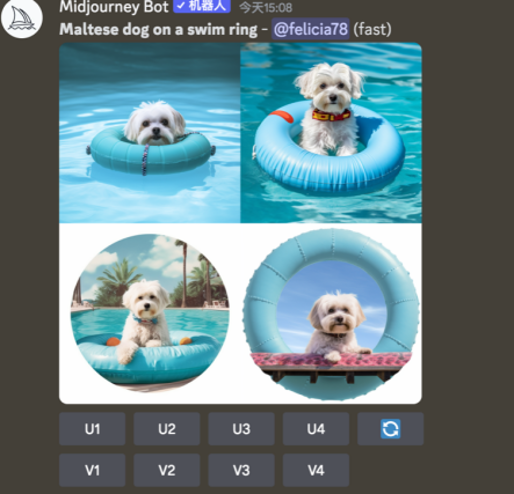
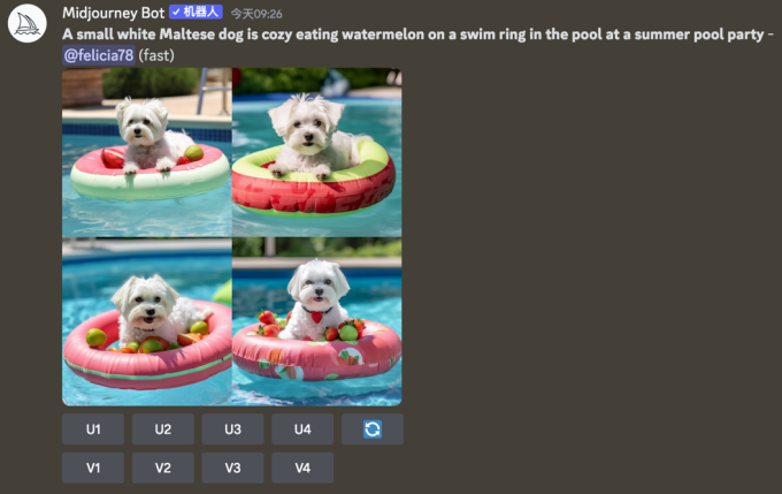
Through the use of the tools found in AI on the use of a few seconds to generate high-quality photorealistic images, easy to manipulate, so that the more fine-grained the descriptors, the richer the conditions in the creation of a number of iterations in order to get to meet the high expectations.AI Art Generator is the use of the latest advances in AI to generate images based on textual prompts of the software.
3.1 Comparison process use character creation as an example
3.1.1 Traditional art work production process
Traditional artists follow the following sequence of illustrations when creating artwork (Figure 5): First, the purpose of creating the character needs to be clarified, such as thinking about how to design a character that is soulful and loved by young people. The process of creating an illustrated character involves identifying and brainstorming a theme, and choosing the best design through collision and revision. Then, prepare by selecting the appropriate creative tools based on the character's personality traits and usage scenarios. Next, reference styles similar to the desired character are found and screened. Finally, refine the character's depiction by drawing, laying out, coloring, and adjusting details. Such a detailed creative process takes a longer time to complete.

3.1.2 The process of make art work with AI
AI does not generate images on its own and requires a question-and-answer process from the user. Creators can choose between purposeful and non-purposeful approaches when using AI for character creation.AI makes it easy for people with no drawing experience to generate high-quality character illustrations using simple line drawings or sketches.

Purposeful creation involves the following steps (Figure 6): first, the creator needs to get inspiration or a clear direction for reference, with a particular focus on character content and consideration of how to engage the audience, both in terms of the style of the work and how to increase the appeal (both in terms of theme, inspiration and content). Next, choose to use an AI drawing tool such as Midjourney, download and register the software. Next, choose a method for generating character images, either text-generated or graph-generated, described by images and keywords. Finally, the generated images are filtered or keywords are changed and fine-tuned iteratively. The purposeless creation process is similar to the purposeful approach, but may be higher in expectations, which is a focus for future research.
3.1.3 Artist-intervened AI art production process
Artists who use it will find some of the basic functions relatively quick to get started, but to create satisfying artwork faster and more accurately, they will first need to take the time to understand and learn about some of the hidden buttons and usages in Midjourney (Figure 7).

3.2 A study of user journeys in the production of art work
3.2.1 Questionnaire survey
In further data collection through social media, email and using questionnaires, questionnaires were placed on people from different industries such as the art industry, design industry, education industry, and business, of which 181 participated in the questionnaires, removing invalid information, there were 170 favorable data. This includes demographic information such as age and gender (Table 3), experience of using AI and type of creation, willingness to use and other relevant information.
|
Genders |
Age (20~30) |
Using AI experiences |
AI is a work of art |
|
Gentleman (70%) |
86% |
Yes 90% |
Yes 70% |
|
Female (30%) |
14% |
No 10% |
No 30% |
It's (Figure 8) below shows the types of art respondents are using AI to create, and also shows that AI is being used by more and more younger groups to create art, especially characters.
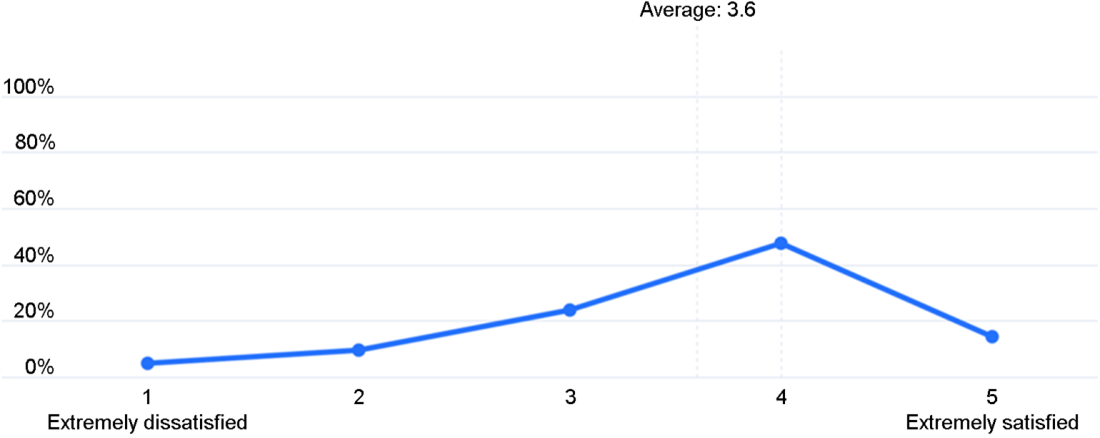
The satisfaction score for creating AI images using AI has a mean at 3.6 and a median at 4 (Figure 9). This means that the images seem to meet expectations, but are not fully satisfactory.

Preferred AI creation satisfaction scoring over traditional creation. The mean is at 3.8 and the median is at 4 (Figure 10). This means that most of the willingness to try to use AI creation compared to traditional creation.
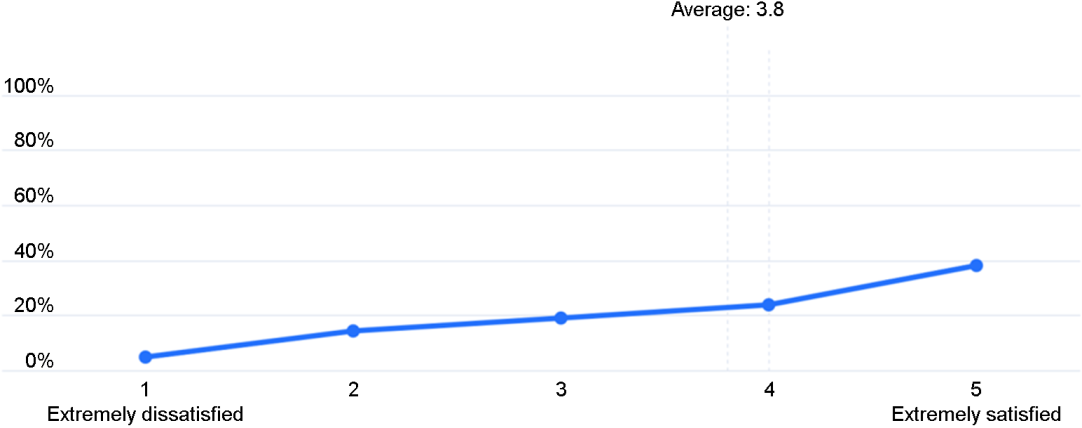
When using AI for creative work (Figure 11). 47.6% of the respondents considered it to be helpful in the early stages of creation, providing them with inspiration and direction. In addition, 33.3% of the respondents viewed increased efficiency as the most important advantage. In addition, 19% of respondents said the most important thing was that the post-production results exceeded expectations. These figures clearly show that users tend to use AI to improve the efficiency of artists. The majority of respondents are satisfied with the images generated through AI, which is especially beneficial when seeking inspiration and guiding directions in the early stages.
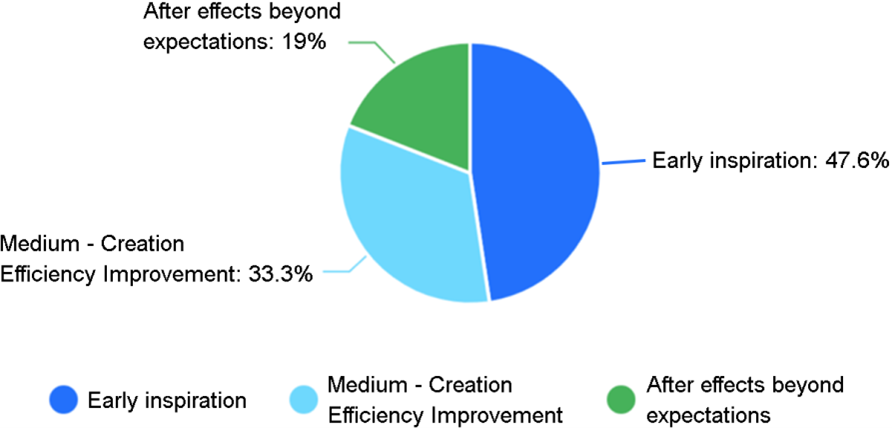
3.2.2 User journey mapping for character creation
For the purpose of this study, a qualitative methodology was used to survey 14 respondents through in-depth interviews in order to investigate the differences in the process of character creation between AI creation and traditional art creation. In the industry, the use of AI for creation is relatively frequent (Figure 12, 13).
In order to understand the artist's creation process in more detail, we asked the following questions:
1. what steps and preparations do you typically need to take in the traditional art character creation process?
2. how long does it take to create a character?
3. what aspects of the traditional approach do you find satisfactory and what are the shortcomings of the traditional approach as opposed to using AI for creation?

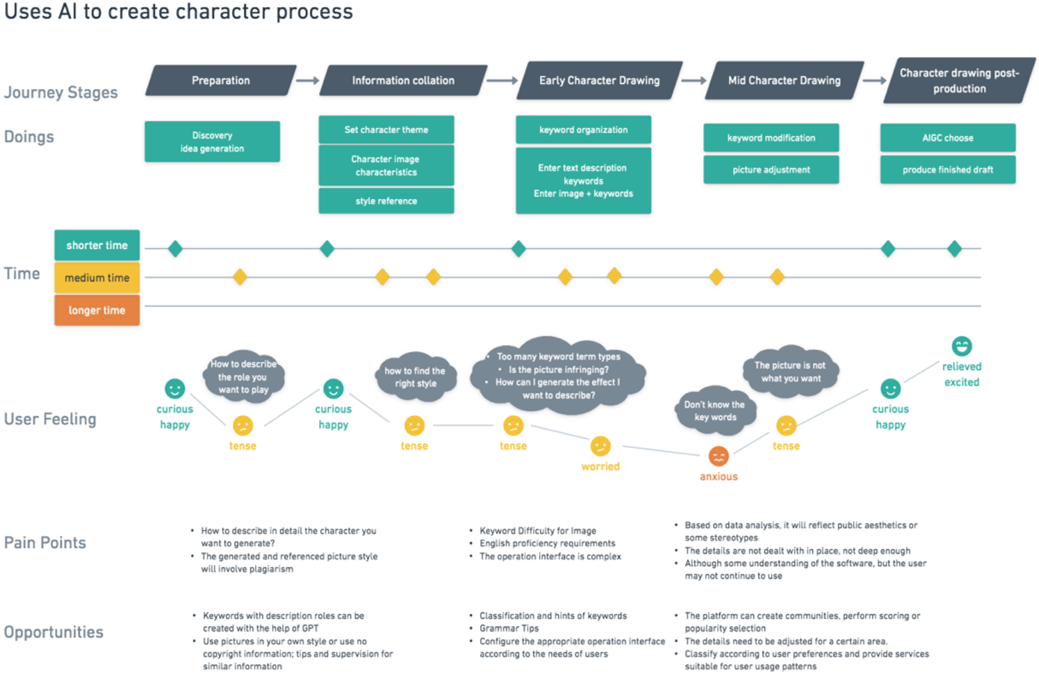
As can be seen from the results of the study, the artists interviewed were quite happy with the process of using AI to create their characters. AI brought high expectations in terms of providing inspiration, with the majority of respondents stating that the initial use of Midjourney was due to their interest in it and their desire to be inspired by the process and to explore different perspectives of creativity. However, some users may not have been clear on how to accurately describe the effect they wanted to achieve due to the limitations of the English language.
On the other hand, interviewees also expressed concerns about copyright issues of the generated images, including whether they could use these generated images for commercial purposes. These factors may limit users' motivation to create with AI to some extent.
It is difficult to quantify the emotion that an artwork evokes in an observer because aesthetics are subjective and susceptible to other factors. In this study, through interviews and research on art creation and AI creation, we can conclude that almost all interviewees generally recognized Midjourney as a creative tool when using AI for creation. Midjourney has the ability to operate across languages and allows users to autonomously adjust the generated images. In some cases, it may even replace a human artist, especially when responding to art order requests. Whether it's text generation or image generation, the use of AI tools produces noticeable perceptual effects, but also has certain limitations.
4.1 Discussion
The value of art is difficult to define and measure. Perhaps AI has changed the way art is produced, but it has not really changed the art form (Tao et al., 2023). On the one hand, AI painting technology can give users more inspiration and creativity and avoid repetitive and tedious work. On the other hand, AI also promotes the integration of art and technology. VR virtual reality paintings, augmented reality technology animations, dynamic posters, etc. Therefore, the integration of art and technology is always the theme of the times. AI may also carry the art of this era, so in the future the current works of AI may also be a kind of art, and AI and art design work together.
The originality and content copyright issues of AI paintings have caused widespread controversy, and the current development is still in a state of freedom and diversity. So far, there are no clear regulations on the ownership of intellectual property rights for products created by AI. The model of giving priority to copyright ownership and allocation will become the driving force for industry development in the future (Ma, 2023). In the existing creative process, AI tools are mainly used as auxiliary tools to help artists generate images, while the real creative inspiration and decisions still come from the artist. Therefore, we need to deeply understand the role of AI in artistic creation, think about how to evaluate the originality of AI-generated art, and how to promote the application of AI in artistic creation while respecting and protecting the original rights of artists.
In previous research, scholars have realized imaginative drawing creation through text-based Chat GPT, whose artistic knowledge can be used to help generate art in parallel art (Guo et al., 2023). Some other researchers study the limitations and challenges of Chat GPT and AI painting techniques in the field of design from a design perspective, exploring the potential impact of generative AI on design and ways to build and apply design systems (He et al., 2023). Meanwhile, other scholars are exploring the application of AI image generation technology in personalized cultural and creative product design to provide new ideas for cultural and creative product design (Wang et al., 2020).
Relevant scholars are more concerned with the effects of AI generation and the techniques used, and there is a lack of research on the generation process. The aim of this study is to provide artists and non-artists with an understanding of the process of character creation using AI tools, and to explore the tools used by both populations when pursuing the goals of commercial activities. Through such a study, we are able to tap into the differences and improve the efficiency and quality of results of applications in different fields, as well as analyze the overall environment and discover potential business value. However, in terms of current AI art creation methods, accurately expressing emotions remains a challenging issue, with more focus on user feedback and expression during the creation process. Therefore, through the study of user-centered information behavior, it is necessary to quantify the impact of the interaction between the user and the AI on the interaction experience in human-computer collaboration, which is likewise a future development topic (Jiang et al., 2022). In addition, the ethical system is yet to be improved in the field related to AI technology, and it is more important to always pay attention to the balance of values (Ma, 2023). Meanwhile, in order to improve the user experience, AI developers should work on optimizing the user interface and interaction to make it easier to use and understand.
4.2 Limitations and future research
Artistic creation is inseparable from the innovation of human thoughts, emotions, and inspiration. When AI painting will become a method with broad application prospects and value, people will adjust their creative practices and languages (Wang, 2023). The needs of artists are diverse, and the images generated by AI have a certain degree of randomness. The challenge in the future is how to further improve AI tools to achieve more accurate content generation. Technical issues, AI relies on big data, deep learning version replacement and other technologies. It also requires the practitioner's own abilities.
4.3 Conclusion
The primary objective of this study is to improve the performance of AI artists from a technical perspective by using AI platforms and training methods that encompass aspects such as image quality, text alignment, text generation, inference time, and training efficiency. This study contributes to the process of AI in character creation, which can help to promote the sustainable development of AI in the field of art, and provides further expansion of the IP of painted characters in the possible space.
The research process of AI artwork centered on character production is not only the process of creating characters, but also the process of exploring and innovating new trends. By combining the powerful language of keywords with AI artists, many novel and interesting developments have been triggered. Users showed a strong inclination towards the use of AI for creation in order to increase the efficiency of artists. Most respondents found the images generated through AI to be meaningful and commercially usable, especially when searching for inspiration and determining direction upfront.
While AI can replace the painting process to some extent, it cannot replace the joy and exploration that artists experience during the creative process. Painting remains a unique journey of discovery and happiness for human creators. However, AI can serve as an invaluable and practical tool to inspire creativity and exploration, save time and increase the efficiency of painting. As AI technology continues to evolve and become more popular, it will fulfill users' needs and deep emotional bodies. It is believed that in the future once the technology matures, these AI tools will revolutionize our work and life.
References
1. Aditya, R., Hierarchical Text-Conditional Image Generation with CLIP Latents. http://arxiv.org/abs/2204.06125 (retrieved Apr 13, 2022).
Google Scholar
2. Aela, E., Artificial Intelligence: How AI Is Changing Art. Aelaschool. https://aelaschool.com/en/art/artificial-intelligence-art-changes/ (retrieved Apr 1, 2023).
3. Ahmed, E., Liu, B.C., Mohamed, E. and Marian, M., CAN: Creative Adversarial Networks, Generating "Art" by Learning About Styles and Deviating from Style Norms. Arxiv. 2017. https://arxiv.org/abs/1706.07068 (retrieved June 21, 2017).
Google Scholar
4. AIGREEM Online. https://aigreem.com/en (retrieved July 14, 2023).
5. Alice, B., "Who Inspires Who?" Aesthetics in Front of AI Art. Philinq, 2021. https://doi.org/https://doi.org/10.4454/philinq.v9i2.367 (retrieved August 8, 2021).
Google Scholar
6. Chamberlain, R., Mullin, C., Scheerlinck, B. and Wagemans, J., Putting the art in artificial: Aesthetic responses to computer-generated art. Psychology of Aesthetics, Creativity, and the Arts, 12(2), 177-192, 2018. https://doi.org/10.1037/aca0000136
Google Scholar
7. DALL-E API Now Available in Public Beta. https://openai.com/blog/dall-e-api-now-available-in-public-beta (retrieved July 15, 2023).
8. Deng, Y, "Application of Artificial Intelligence in Art Design," 2021 International Conference on Computer Technology and Media Convergence Design (CTMCD), Sanya, China, 200-203, 2021. doi: 10.1109/CTMCD53128.2021.00049.
Google Scholar
9. Discord Website. https://discord.com (retrieved July 14, 2023).
10. Eugene, C., Art by Computing Machinery: Is Machine Art Acceptable in the Artworld? ACM Transactions on Multimedia Computing, Communications, and Applications, 15(2), 1-7, 2019. https://doi.org/10.1145/3326338
Google Scholar
11. Feng, T., Agency, Simulation, and Techne: A Philosophical Interpretation of the Production of Literature and Art by Artificial Intelligence https://www.researchgate.net/publication/370158829_daili_moniyujiyi_rengongzhinengwenyishengchandezhexuechanshi Agency_Simulation_and_Techne_A_Philosophical_Interpretation_of_the_Production_of_Literature_and_Art_by_Artificial_Intelligence (retrieved March 30, 2023).
12. Guo, C., Lu, Y., Dou, Y. and Wang, F.Y., Can ChatGPT boost artistic creation: The need of imaginative intelligence for parallel art, IEEE/CAA Journal of Automatica Sinica, 10(4), 835-838, 2023. doi: 10.1109/JAS.2023.123555
Google Scholar
13. He, J.Y., Wu, Q.W., Chen, R.Q. and Le, J.Y., Analysis of ChatGPT and AI painting collaborative design system under the generative artificial intelligence revolution [J]. Design, 8(4), 2507-2515, 2023. https://doi.org/10.12677/Design.2023.84304
14. Hong, J., Bias in Perception of Art Produced by Artificial Intelligence. In: Kurosu, M. (eds) Human-Computer Interaction. Interaction in Context. HCI 2018. Lecture Notes in Computer Science, 10902. Springer, Cham. 2018. https://doi.org/10.1007/978-3-319-91244-8_24
Google Scholar
15. Jeon, B., AI Art Creation Case Study for AI Film & & Video Content. The Journal of the Convergence on Culture Technology, 7(2), 85-95, 2021. https://doi.org/10.17703/JCCT.2021.7.2.85 (retrieved May 31, 2021).
Google Scholar
16. Jiang, T.T., Xu, Y.R., Fu, S.T. and Lu, W., Research on human-intelligence interactive experience: Injecting new impetus into the development of human-centered artificial intelligence [J]. Library and Information Knowledge, 39(4), 43-55, 2022. doi: 10.13366/ j.dik.2022.04.043
17. Lan, J., Jean, P., Mehdi, M., Xu, B., David, W., Sherjil, O., Aaron, C. and Yoshua, B., Generative Adversarial Nets. arXiv:1406.2661v. https://arxiv.org/abs/1406.2661 (retrieved Jun 10, 2014).
Google Scholar
18. Liu, L.S., Is It "Drawing" or "Stealing"? --The Industry Controversy Caused by AI Painting. Http://Www.Chinawriter.Com.Cn/. http://wyb.chinawriter.com.cn/content/202302/10/content68675.html (retrieved January 1, 2018).
19. Luke, S. and Kate, C., The Work of Art in the Age of Artificial Intelligence: What Artists Can Teach Us About the Ethics of Data Practice, Surveillance & Society, 17(3/4), 442-455, 2019. https://doi.org/DOI:10.24908/ss.v17i3/4.10821
Google Scholar
20. Ma, Y.Y., Future of AI painting from a legal perspective: the balance between freedom and control. Chinese Journal of Intelligent Science and Technology, (3), 424-430, 2023. DOI: 10.11959/j.issn.2096-6652.202331
21. Marian, M. and Ahmed, E., Art, Creativity, and the Potential of Artificial Intelligence, 8(1), 26, 2019. https://doi.org/10.3390/ arts8010026
Google Scholar
22. Midjourney Website. https://www.midjourney.com (retrieved July 14, 2023).
23. Reimann, N., IBM Will Stop Hiring Humans For Jobs AI Can Do, Report Says. Forbes. https://www.forbes.com/sites/nicholasreimann/ 2023/05/01/ibm-will-stop-hiring-humans-for-jobs-ai-can-do-report-says/?sh=c6206c853971 (retrieved May 1, 2023).
24. Roosa, W., Johanna, H. and Riina, L., Redefining Creativity in the Era of AI? Perspectives of Computer Scientists and New Media Artists, Creativity Research Journal, 2022. DOI: 10.1080/10400419.2022.2107850 (retrieved Aug 18, 2022).
Google Scholar
25. Salvador Dalí. Wikipedia. https://en.wikipedia.org/wiki/Salvador_Dal%C3%AD (retrieved July 14, 2023).
26. Stable Diffusion Online. Stablediffusionweb. https://stablediffusionweb.com/ (retrieved July 14, 2023).
27. Sumit, D., Aritra, D., Akash, P. and Nabamita, R., Applications of Artificial Intelligence in Machine Learning: Review and Prospect. International Journal of Computer Applications, 115, 31-41, 2015. DOI: 10.5120/20182-2402.
Google Scholar
28. Tao, F., Zou, X.H. and Ren, D.N., The Art of Human Intelligence and the Technology of Artificial Intelligence: Artificial Intelligence Visual Art Research. In: Shi, Z., Pennartz, C., Huang, T. (eds) Intelligence Science II. ICIS 2018. IFIP Advances in Information and Communication Technology, 539. Springer, Cham. https://doi.org/10.1007/978-3-030-01313-4_15
Google Scholar
29. Ting, T.T., Li, L.Y., Amirul, I. and Ramanathan, P., Artificial Intelligence Art: Attitudes and Perceptions Toward Human Versus Artificial Intelligence Artworks, 2022. https://doi.org/10.1063/5.0162434
Google Scholar
30. Turing, A.M., I.—computing machinery and intelligence, Mind, Volume LIX, Issue 236, 433-460, 1950. https://doi.org/10.1093/ mind/LIX.236.433
Google Scholar
31. Wall-E. Wikipedia. https://en.wikipedia.org/wiki/WALL-E (retrieved July 14, 2023).
32. Wang, X.H., Qin, J.Y. and Quan, H.C., Personalized cultural and creative product design method based on AI painting generation. Packaging Engineering, 7-12, 2020. doi: 10.19554/j.cnki.1001-3563.2020.06.002.
33. Wang, C., AI-driven digital image art creation: methods and case analysis [J]. Chinese Journal of Intelligent Science and Technology, 5(3), 406-414, 2023.
34. Xu, P.J., Zhang, L.X., Li, H., Yoo, C. and Pan, H.Y., Is Everyone an Artist? A Study on User Experience of AI-Based Painting System. Applied Sciences, 13(11), 6496, 2023. https://doi.org/10.3390/app13116496
Google Scholar
35. Zhang, J., From "Space Opera" to Chat GPT, embrace AI and stay alert. https://New.Qq.Com/Rain/a/20230214A01ZPZ00.Html (retrieved May 26, 2023).
PIDS App ServiceClick here!